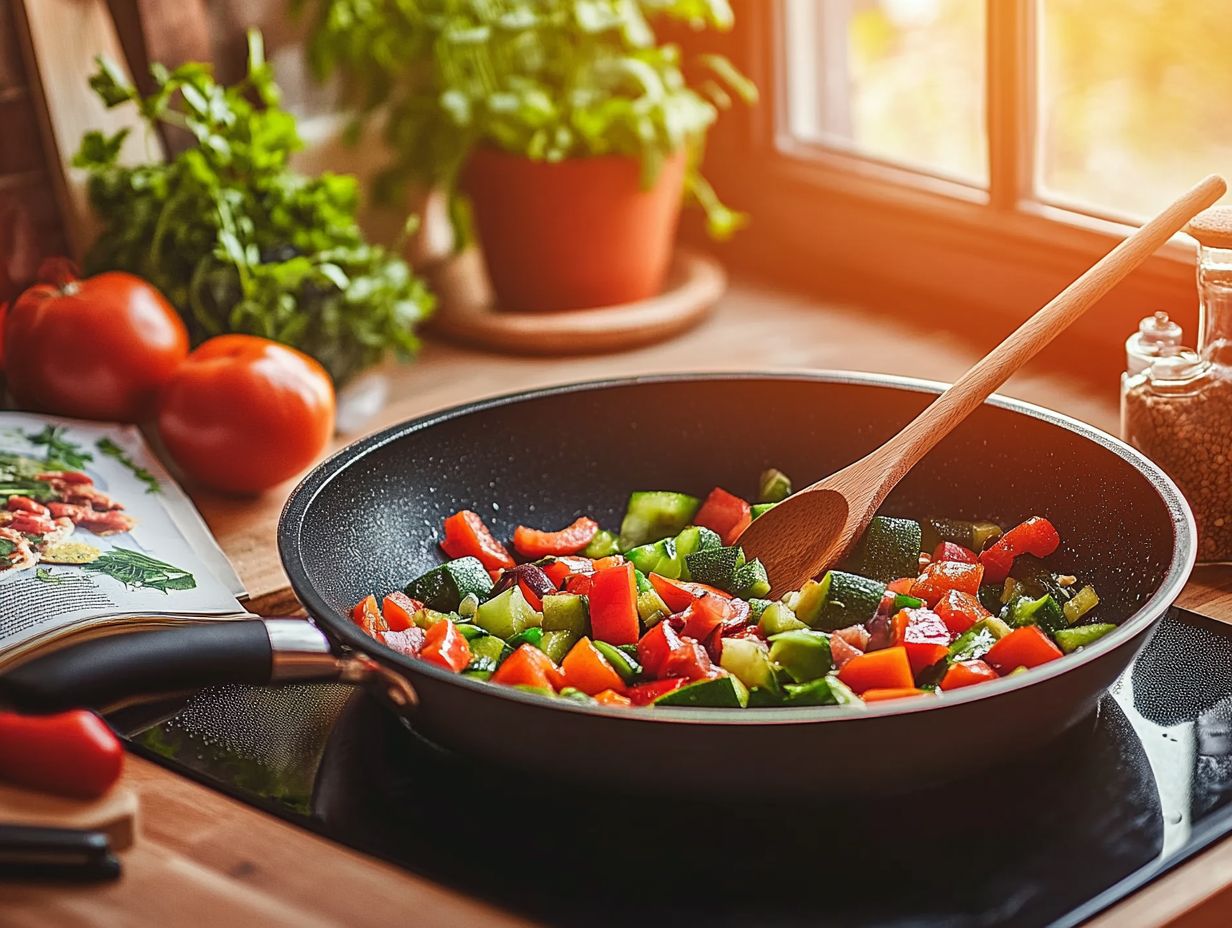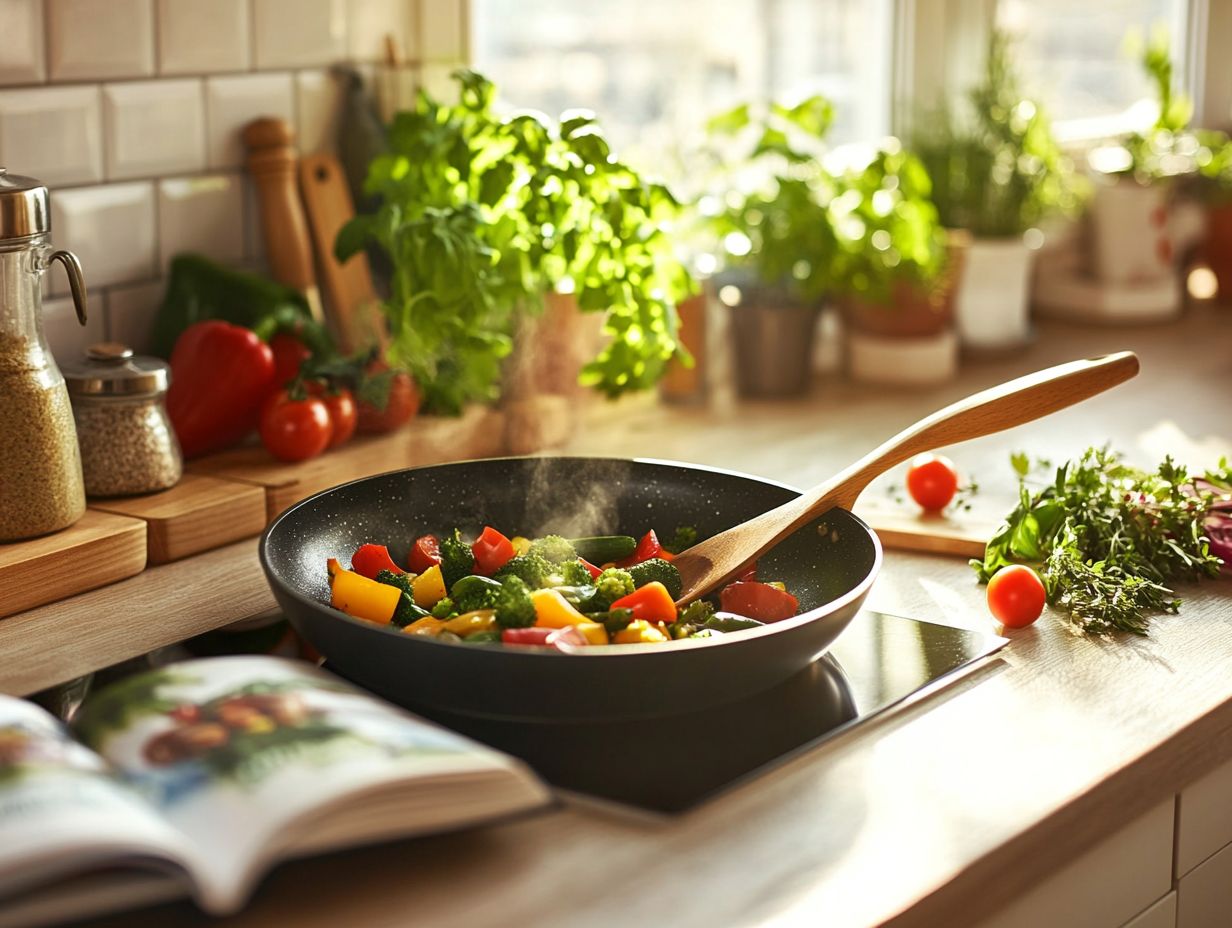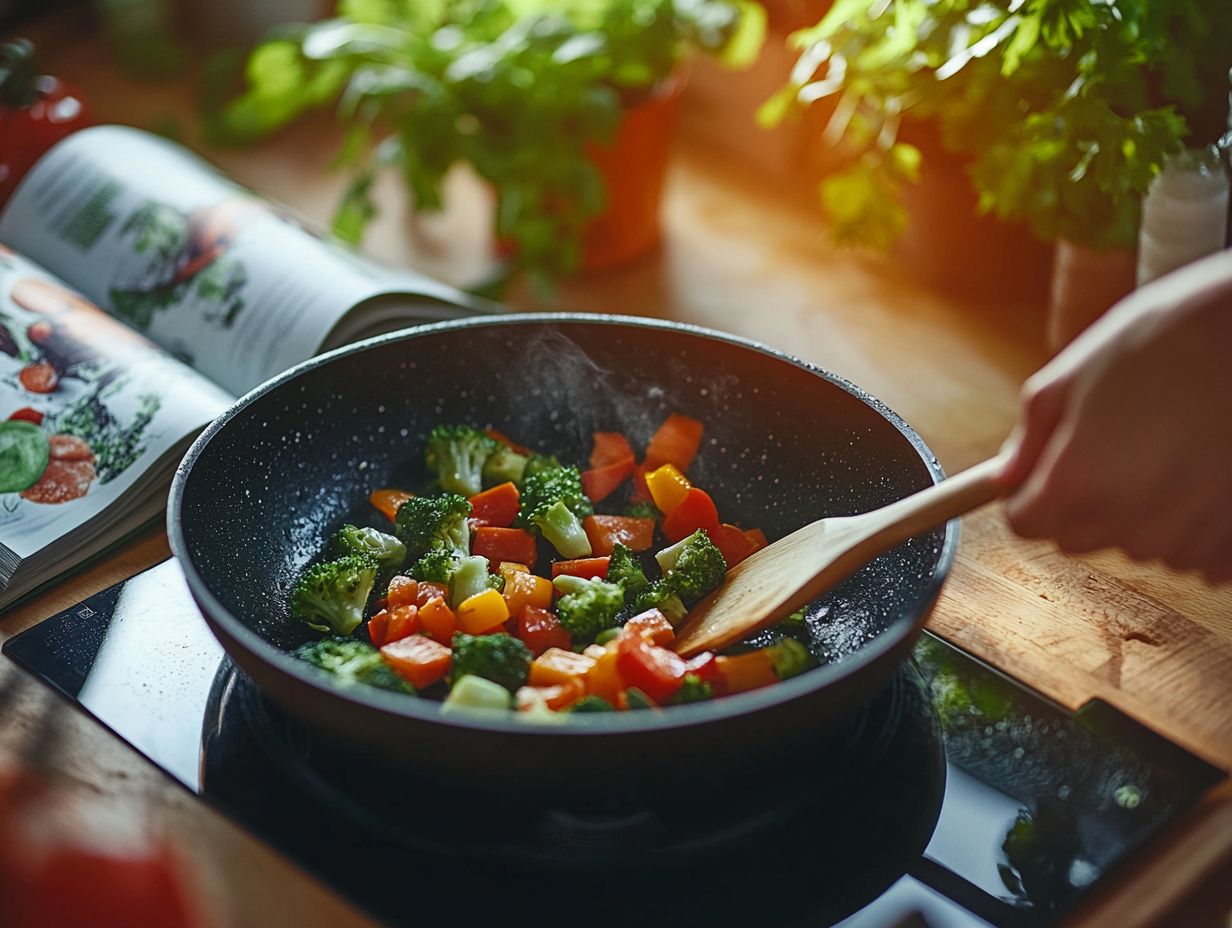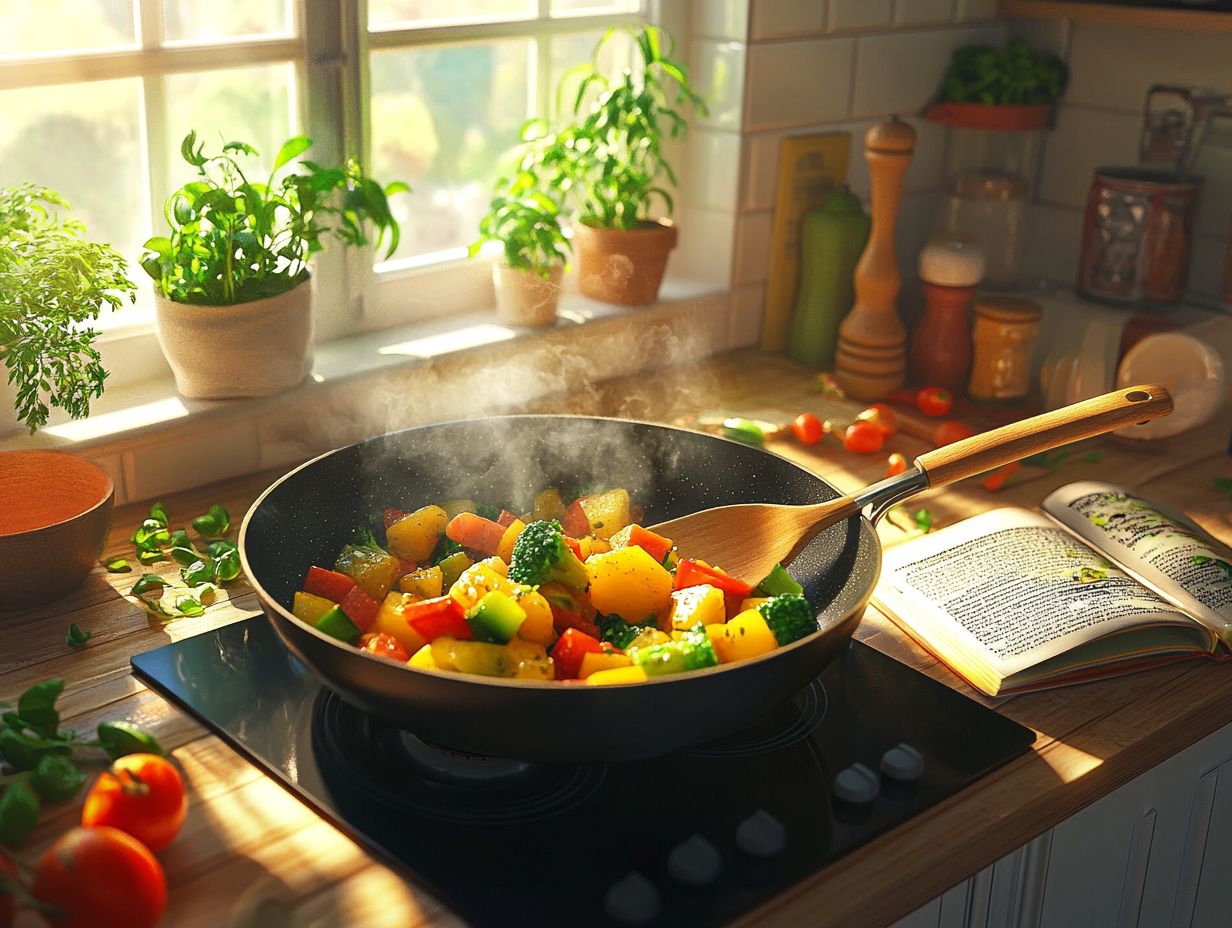Healthy cooking methods and meal planning play a vital role in cancer prevention by preserving nutrients and reducing the formation of harmful compounds. A diet rich in fruits, vegetables, and whole grains, combined with appropriate cooking techniques, can significantly lower cancer risk.
Focusing on methods such as:
- steaming (including poaching)
- baking
- sautéing with healthy oils
supports nutrient retention and minimizes cancer-promoting substances. These cooking methods help maintain the integrity of antioxidant-rich foods like berries, broccoli, and kale, which offer protective benefits.
In contrast, avoiding methods like frying, deep-frying, and charbroiling, which introduce unhealthy fats and carcinogens, is crucial for health. Incorporating cancer-fighting foods, such as:
- turmeric (curcumin)
- garlic (allicin)
- cruciferous vegetables
into your diet further enhances cancer prevention efforts.
Understanding the impact of diet and cooking on cancer risk empowers individuals to make informed choices that support long-term health.
Key Takeaways:
The Link Between Diet and Cancer

Diet can affect cancer risk. Certain foods and nutrients can increase or decrease cancer risk by impacting cell growth and inflammation.
Consuming a balanced diet with fruits, vegetables, and whole grains may lower cancer risk.
Research shows that diet modification and healthy cooking can support cancer prevention and treatment.
Understanding the Connection
The connection between diet and cancer involves the impact of food choices, cooking methods, and food safety on cancer risk.
A diet rich in fruits, vegetables, whole grains, and lean proteins can reduce the risk of cancer.
Antioxidant-rich foods, such as berries, broccoli, and kale, offer protective benefits.
Healthy cooking methods, like steaming and poaching, preserve nutrients and reduce harmful substances. Utilizing cooking oils such as extra-virgin olive oil and avocado oil can also provide health benefits.
Cooking Methods That Promote Cancer Prevention
Cooking methods that promote cancer prevention include steaming, baking, roasting, and sautéing.
Steaming preserves nutrients and minimizes harmful compounds.
Baking reduces the need for unhealthy fats.
Sautéing with healthy fats like extra-virgin olive oil and avocado oil supports cancer prevention and enhances the flavors of seasonal vegetables.
Grilling and Broiling
Grilling involves cooking food on a grill with direct heat from below, often outdoors, to create a charred finish.
Broiling uses direct heat from above in an oven to cook food, resulting in a similar charred texture.
Both methods can reduce harmful compounds like heterocyclic amines (HCA) when temperatures are kept at or below 300°F (150°C).
Using marinades and incorporating antioxidant-rich foods like bell peppers, broccoli, and tomatoes can enhance flavor and health benefits when grilling or broiling.
Steaming and Boiling

Steaming and boiling are cooking methods that preserve nutrients in foods like vegetables. Steaming is often preferred in nutritional services for its nutrient retention benefits.
Steaming involves cooking food with steam, which retains more nutrients and flavors.
Boiling cooks food in water, which can lead to nutrient loss.
Both methods are used to prepare healthy meals, but steaming is generally preferred for nutrient retention.
Baking and Roasting
Baking is a cooking method that uses dry heat in an oven, typically at lower temperatures, to cook food evenly. This method is part of healthy cooking techniques recommended for cancer prevention.
Roasting is a cooking method that uses dry heat in an oven, typically at higher temperatures, to create a browned, crisp surface on food.
Baking is ideal for foods like bread, cakes, and casseroles. Roasting is ideal for meats and dense vegetables.
Both methods enhance natural flavors and can be healthy by reducing the need for excessive oils or fats. They are part of the culinary practices recommended for maintaining healthful calories.
Cooking Techniques to Avoid for Cancer Prevention
Cooking techniques to avoid for cancer prevention include frying, deep frying, charbroiling, and blackening.
Frying and deep frying increase cancer risk by introducing unhealthy fats and high calories.
Charbroiling and blackening produce carcinogens such as PAHs and HCAs that can harm health. Understanding cooking temperatures and marinating techniques can help in HCA reduction.
Frying and Deep Frying
Frying is a cooking method where food is cooked in oil or fat.
Deep frying submerges food completely in hot oil, resulting in a crispy texture.
These methods can increase unhealthy fat intake, elevate heart disease risk, and contribute to cancer risk through the introduction of carcinogens.
Healthier alternatives include baking, grilling, or air frying with less oil.
Charbroiling and Blackening

Charbroiling is a cooking method that grills food at high temperatures, creating a charred exterior.
Blackening involves coating food, often fish or chicken, with spices and cooking it in a hot pan until the surface turns black.
Both methods can produce carcinogens like PAHs and HCAs due to high heat, posing health risks.
Microwaving and Food Safety
Microwaving is a method of cooking food using microwave radiation to heat water molecules within the food, providing quick and convenient cooking. It is essential to use microwave-safe containers to ensure food safety.
To retain nutrients and improve cooking quality, use microwave-safe containers, add water to create steam, and avoid overcooking to prevent nutrient degradation.
Incorporating Cancer-Fighting Foods in Your Diet
Cancer-fighting foods contain nutrients and compounds that help reduce cancer risk. Key cancer-fighting foods include:
- turmeric (curcumin)
- garlic (allicin)
- cruciferous vegetables (phytonutrients)
Incorporate cancer-fighting foods into your diet by adding turmeric to meals, using garlic in cooking, and consuming broccoli, kale, or Brussels sprouts regularly. Anti-cancer phytonutrients in these foods contribute to lowering cancer risk.
Key Nutrients and Foods to Include
Key nutrients for cancer prevention include antioxidants, vitamins, and minerals.
Foods rich in these nutrients include cruciferous vegetables like broccoli, which contains sulforaphane, and tomatoes, which are high in lycopene. Specific recipe recommendations can help incorporate these foods into your diet regularly.
These foods help detoxify carcinogens and protect against prostate and other cancers.
Frequently Asked Questions

What are some healthy cooking methods for cancer prevention?
Some healthy cooking methods for cancer prevention include steaming, roasting, grilling, and baking. These methods help to retain the nutrients and minimize the use of unhealthy ingredients like added fats and oils.
Why are these cooking methods recommended for cancer prevention?
These cooking methods are recommended for cancer prevention because they help to preserve the nutrients in food that are known to have cancer-fighting properties. They also reduce the intake of unhealthy fats and oils that have been linked to an increased risk of cancer. Cooking tips and dietary guidelines can further enhance their effectiveness.
Are there any specific foods that should be cooked using these methods for cancer prevention?
Yes, there are specific foods that are recommended to be cooked using these methods for cancer prevention. These include vegetables, fruits, lean proteins, and whole grains. These foods are rich in antioxidants and other cancer-fighting nutrients that are best preserved using healthy cooking methods.
Can I still enjoy my favorite dishes while following these healthy cooking methods for cancer prevention?
Yes, you can still enjoy your favorite dishes while following these healthy cooking methods for cancer prevention. You can modify your recipes by using healthier ingredients and cooking methods. For example, instead of frying chicken, you can grill, braise, or bake it. This will still give you a delicious meal while reducing the risk of cancer.
Are there any cooking methods that should be avoided for cancer prevention?
Yes, there are cooking methods that should be avoided for cancer prevention. These include deep-frying, char-grilling, and microwaving in plastic containers. These methods can produce harmful chemicals that have been linked to an increased risk of cancer.
What are some other lifestyle changes that can be made for cancer prevention?
In addition to using healthy cooking methods, other lifestyle changes that can help prevent cancer include regular exercise, maintaining a healthy weight, avoiding tobacco and excessive alcohol consumption, and getting regular screenings for early detection of cancer. These changes, along with healthy cooking methods, can greatly reduce the risk of cancer.





